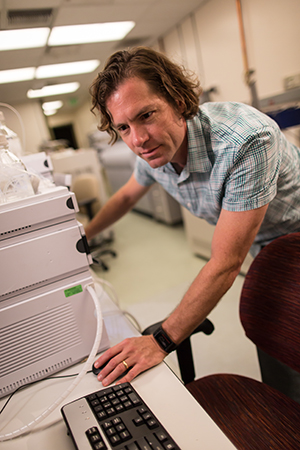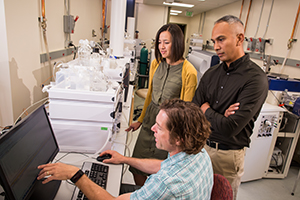
Author: Stacy W. Kish

Scott Summers, PhD, Department Chair of Nutrition and Integrative Physiology was drawn to research to understand why his father, a dedicated, fit runner, was battling diabetes. Through his investigations, he began to appreciate how metabolism, the chemical processes in cells essential for creating of breaking down energy, played a central role in the development of the disease. He knew he was on to something big, but in the early 2000s, University of Utah lacked the facilities to advance his work.
“I left [the U] in 2008 because we didn’t have a means to measure metabolites, which I needed for my research,” Summers said. In this quest, he moved from Utah to Australia and finally Singapore to establish his own core, but his efforts were soon overshadowed by James Cox, PhD, who established the Metabolomics Core at U of U Health.
It was an unexpected reason – the success of the new Metabolomics Core – that drew Summers back to the university in 2016.
Metabolomics is the study of the unique chemical fingerprint left by cells. This fingerprint is composed of metabolites, small molecules that are the intermediary or end product of chemical reactions. The Metabolomics Core at U of U Health empowers researchers at the U and beyond to sort through the stream of metabolites with the aim of understanding disease and developing new treatments.
“We are one of the best equipped metabolomics centers instrumentation-wise in the country, providing a broad range of “-omics” capabilities to study many types of organisms,” said Cox, Director of the Metabolomics Core. “We have become known as a serious place to study metabolism.”
Metabolism of Toxic Fat
Today, Summers uses the Core in his study of ceramides, a family of waxy lipids that cause dysfunction in other lipids in the body.In his research, Summers has drawn a link between ceramides and diabetes and fatty liver disease. In essence, the ceramides lower the metabolic activity in fat tissue.
“One in four patients has a mutation in a gene associated with ceramides, and these patients have a predisposition for diabetes,” Summers said. “We are screening 5,000 patient samples to look at the relationships between ceramides and genetic mutations to establish clinical end-points to see if we can stratify patients for treatment.”
Summers work shows that blocking ceramides in animal models prevents the development of these diseases. He is now examining how drug or behavioral interventions influence ceramide levels with an eye towards developing new therapies to treat diabetes and other metabolic diseases.
“This is a new paradigm for how we study how the body senses this fat and I think we are heading to a real therapy for treating these disorders,” Summers said. “The Metabolomics Core has made my science better.”
Engaging the Core
Established more than a decade ago, the Metabolomics Core was designed to provide metabolomic analysis to the hematology community using a gas chromatograph-mass spectrometry. Since that time, the Core has expanded beyond its initial function to provide comprehensive profiling of the metabolome, which include all the metabolites within cells, tissues, and model organisms, using two additional chemical analysis platforms — liquid chromatography-mass spectrometry and nuclear magnetic resonance.

The Core can evaluate the biochemical pathways for amino acids, organic acids, carbohydrates, nucleotides, lipids, di- and tri-peptides, Krebs cycle intermediates, and full lipid profiles.
While metabolomics remains a comparative science, the Core processes every sample using two distinct but overlapping procedures. At the same time, a non-targeted analysis uses data mining software to detect differences in the chromatographic peaks of paired samples. Using targeted analysis, every chromatograph sip of the sample is searched for known metabolites.
“We can use the broader non-targeted approach for hypothesis development and use these results to do a deep dive using the targeted approach,” Cox said. “The Core also provides a broad range of other omics.”
Cox is referencing the latest additions to the Core: the newly initiated fluxomics, which provides researchers an analysis of the flux through metabolic pathways, as well as lipidomics, which provides a large-scale study of the pathways and networks of cellular lipids in biological systems.
It was the later omic that drew Summers back to the U and has opened the door to taking his research in new directions. Summers is not alone. Researchers, clinicians, and educators with the Diabetes and Metabolism Research Center at U of U Health use this unique resource in their research related to diabetes, metabolism and overall metabolomic health.
Leveraging Weight Loss
When it is cold outside, your body shivers to keep warm. In fact, your body burns more energy in the cold to maintain a core body temperature of 98.6 °F. Claudio J. Villanueva, PhD, assistant professor in Biochemistry at U of U Health and his team are exploring this facet of metabolism.

According to Villanueva, the Metabolomics Core allows his team to use this cutting-edge technology to make new discoveries, like the role of acylcarnitines, a new metabolite that provides fuel during cold exposure.
“The exciting part is that we are developing a deeper understanding of how metabolism changes when the temperature decreases,” Villanueva said. “We can use these findings to develop new therapeutic intervention for diabetes and obesity.”
Resolving Insulin Resistance
Micah Drummond, PhD, associate professor of Physical Therapy in the College of Health at the U, is interested in understanding why some people do not respond to insulin. Insulin resistance occurs when the body cannot regulate blood sugar levels, leaving patients susceptible to diabetes and obesity. His research has focused on the role of muscle ceramides in older adults during short-term periods of inactivity.
“With the Core, I am looking for potential cellular mediators of inactivity that can induce insulin resistance,” Drummond said. “James Cox and Alan Maschek with the Metabolomics Core have been extremely valuable in providing advice and identifying these specific lipid intermediates in muscle.”
Drummond aims to translate his research from cells to animals to clinical research to find new therapies to help patients.
Metabolism and Disease
Jared Rutter, PhD, professor in Biochemistry at U of U Health is using the Core to understand how metabolism affects disease. Cells must constantly monitor their nutrient, metabolic, and hormonal environments and adjust their behavior accordingly. These changes play important roles in the pathogenesis of heart failure, cancer, and neurodegenerative disorders.
“I’m excited to discover new things about how cells work,” explains Rutter. His research team is trying to understand how metabolism affects normal and disease processes in individual cells and in the body.“The Core has been instrumental in helping us to discover new things about how cells work or fail to work to devise more precise ways to intervene therapeutically.”
The Core Today and Beyond

The Core can evaluate the biochemical pathways for amino acids, organic acids, carbohydrates, nucleotides, lipids, di- and tri-peptides, Krebs cycle intermediates, and full lipid profiles.
During the past year, the Core has provided service to more than 25 departments and 60 users at the U. Beyond the home institution, the Core maintains grants or subcontracts with investigators at Baylor College of Medicine, Yale University, Mt. Sinai School of Medicine, and University of Rochester Medical Center. To learn more about analytical services and fees, visit the Metabolomics Core.